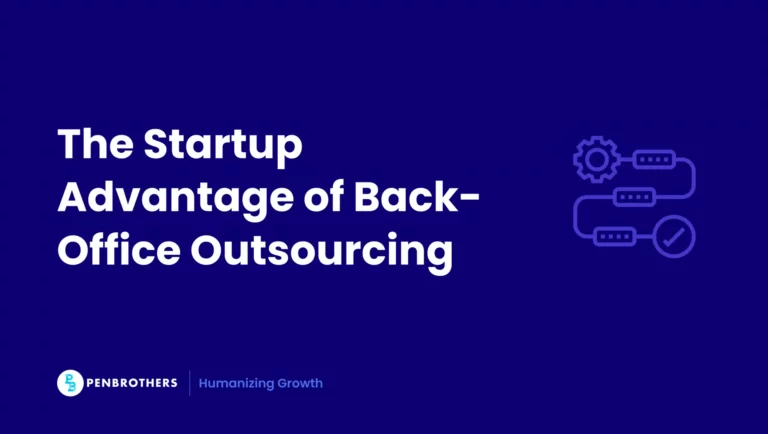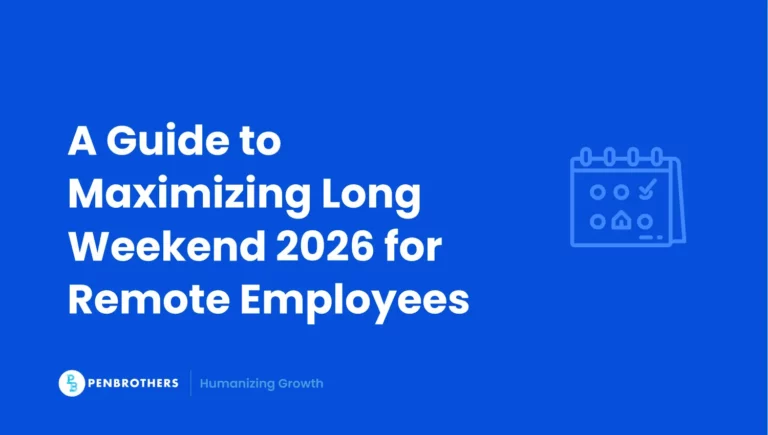Offshoring isn’t new. But the way companies do it today is vastly different. We’ve worked with clients who scaled their operations faster, reduced costs, and found top-tier talent—all because they made one smart move: they hired in the Philippines.
At Penbrothers, we’ve seen how hiring Filipino professionals transforms businesses. Not just by filling roles, but by building reliable, motivated, and skilled teams that become an extension of your core. With more companies going global, understanding how to hire well in the Philippines is no longer optional—it’s a growth opportunity waiting to be unlocked.
In this article, I’ll share 10 lessons learned from working with international startups, scale-ups, and enterprises looking to hire smarter in the Philippines.
Key Takeaways
- A Strategic Advantage, Not Just a Cost-Saving Tactic: Hiring in the Philippines provides significant cost savings (up to 70%), but its true strategic value lies in accessing a deep pool of highly educated, English-proficient, and culturally aligned talent that can accelerate business growth.
- The Talent Pool is Diverse and Highly Skilled: A common lesson learned is that the Filipino talent pool has evolved far beyond traditional customer support. Companies are successfully hiring for a wide range of specialized, high-skill roles, including software development, cybersecurity, digital marketing, and finance.
- A “Skills-First” and Culturally-Aware Hiring Process is Essential: A structured hiring process is critical for success. This includes using practical work tests for smart screening. More importantly, managers must understand that Filipino culture values modesty, so quiet confidence in an interview should not be mistaken for a lack of skill; the candidate’s work and assessments should be given more weight.
- Direct Hiring is Risky; an EOR Model is the Compliant Solution: Directly hiring a Filipino employee without a local legal entity creates significant legal and tax risks for a foreign company (e.g., “permanent establishment” and non-compliance with labor laws). The safest and most effective method is to partner with an Employer of Record (EOR), which handles all local payroll, taxes, benefits, and labor law compliance.
Lesson 1: There Are Clear-Cut Benefits to Hiring in the Philippines
Lower Costs, World-Class Talent
You save more than just money. Hiring in the Philippines reduces salary costs by up to 70% compared to U.S. and European markets. But the real value? It comes from the talent itself. Filipinos are highly educated, speak excellent English, and have global work experience.
In fact, according to the IT and Business Process Association of the Philippines (IBPAP), the IT-BPM industry continues its aggressive growth. After a strong 2024, the industry is on track to meet—and even exceed—its 2025 targets of $40 billion in revenue and 1.9 million full-time employees. This surge reflects the country’s strong pool of digital and customer-centric talent, driven by increasing global demand from sectors like banking, healthcare, and finance.
English fluency and global communication
The Philippines is consistently ranked as one of the top English-speaking countries in Asia, and business English is widely used. This fluency makes collaboration easier—especially in roles requiring written reports, customer interaction, or cross-border teamwork.
Many Filipino professionals are also familiar with idiomatic and industry-specific English, making communication more natural and efficient. This reduces training time, eliminates miscommunication, and allows teams to hit the ground running from day one. Whether in technical documentation or sales emails, language isn’t a barrier—it’s a bridge.
Shared work culture and adaptability
Filipino employees are known for their service orientation, strong work ethic, and adaptability. They’re often trained in structured corporate environments and are comfortable with tools like Slack, HubSpot, and project management systems.
Most have experience working with global teams and understand Western business norms—like feedback cycles, deliverable deadlines, and async collaboration. They’re quick learners, and their professional agility makes it easy to plug them into your systems and workflows. This alignment speeds up onboarding and reduces the friction typically found in cross-cultural teams.
Willingness to work global time zones
Unlike many other regions, Filipino professionals are open to shifting work hours to match global clients—especially U.S. and Australian teams. This makes them ideal for roles in customer success, support, and real-time collaboration across departments.
It’s common to see Filipino teams working split shifts or graveyard hours without sacrificing productivity. Their flexibility also allows you to offer extended service windows or even 24/7 support without hiring in multiple regions. For businesses that rely on real-time operations, this time zone agility is a huge operational win.
Cultural compatibility and loyalty
Filipino culture emphasizes respect, teamwork, and family-like relationships in the workplace. As a result, Filipino professionals often view their company as an extension of their community, which drives loyalty and retention.
They value mentorship, recognition, and being part of a cohesive team—qualities that align well with collaborative company cultures. Once trust is established, they often go above and beyond, showing strong commitment to team goals and long-term success. That’s why many companies report lower attrition rates and higher morale when they build teams in the Philippines.
Lesson 2: There Are Unexpected Benefits Beyond the Obvious Cost Savings
Lower Operational Costs Beyond Salaries
It’s not just salaries—office space, utilities, and on-site perks all add up fast. By building remote teams in the Philippines, many companies are now able to bypass these hidden expenses altogether. A traditional office setup in cities like New York or Sydney can cost $10,000 to $15,000 per employee annually. This doesn’t even include the initial build-out. According to 2025 commercial construction reports, even a basic U.S. office fit-out now starts at $240 per square foot and can easily exceed $350 for more complex, multi-level spaces.
In contrast, remote Filipino teams often work from home or co-working setups—without expecting subsidized lattes or catered lunches. And no, remote doesn’t mean disengaged. According to various studies, remote workers report up to 20% higher job satisfaction, especially when they’re trusted and supported.
Reduce Risk Through Market Diversification
While many companies looked to Eastern Europe or India in the past, recent global events have made risk diversification critical. The Philippines offers an alternative—politically stable, economically resilient, and less prone to geopolitical volatility.
In fact, the World Bank highlights the Philippines’ economic resilience and strong human capital development as key advantages for employers building remote or offshore teams. As part of the ASEAN region, it also benefits from strong foreign relations and a fast-developing digital economy.
By hiring in the Philippines, you’re not just offshoring—you’re distributing risk and building continuity into your operations.
Lesson 3: Filipino Talent Can Fill Almost Any Role—Not Just Customer Support
Yes, the Philippines is known for its world-class customer service sector. But that’s just the beginning. You can build tech, finance, marketing, legal, HR, and creative teams here.
Recent 2025 labor market analysis confirms this trend. While customer support remains a pillar, the fastest-growing demand is now for specialized roles in digital marketing (SEO/SEM, content), IT (cloud computing, cybersecurity), healthcare services, and creative production.
At Penbrothers, we’ve staffed entire product teams, analytics departments, and growth squads. The versatility of the Filipino talent pool is what makes this market exceptional. And it’s time more companies move beyond stereotypes—here are some common myths about offshore teams that we’ve debunked.
Lesson 4: Fair Pay Looks Different Here—And It Matters More Than You Think
Compensation in the Philippines can be tricky for first-timers. It’s not just about slashing salaries. You need to understand local benchmarks, perks, and what’s considered competitive.
A fair salary, plus internet and healthcare allowances, can go a long way in attracting top talent. According to analysis of Philippine Statistics Authority (PSA) data, the average salary of Filipino professionals is expected to increase by 5.5% in 2025—a reflection of inflation pressure and strong competition for skilled talent. Beyond salary, benefits like HMO coverage (private healthcare), remote work support, and career development remain top drivers of talent attraction and retention.
Working with a partner like Penbrothers helps you navigate this so you don’t just hire fast—you hire right. Check out our Salary Guide for the Philippines to understand role-based compensation expectations in today’s hiring landscape.
Lesson 5: Scaling With Filipino Talent Opens Up New Business Opportunities
Hiring locally often limits growth speed. In the Philippines, companies are building 10-, 20-, even 50-person teams in months, not years.
Lower costs give you the flexibility to experiment with new markets, support functions, or time zones. Whether you’re expanding sales coverage or improving 24/7 customer support, Filipino teams make it happen.
This scale unlocks strategic moves—like launching pilot teams, A/B testing new business units, or decentralizing customer experience ops.
And because Filipino professionals are already well-versed in global tools and systems, integration is quicker than you’d expect.
With the right partner, building agile, cross-functional teams becomes less of a risk—and more of a competitive advantage. See how Luxclusif scaled quickly with Penbrothers to power their international growth strategy.
Lesson 6: Structured Hiring Process Is Critical to Winning Top Filipino Talent
If you’re scaling a team in the Philippines, a messy hiring process will cost you. Top Filipino candidates are often fielding multiple offers—if your recruitment feels slow, unclear, or disorganized, they’ll walk.
We’ve seen the consequences firsthand when companies hire without a solid plan:
- Interviewers aren’t aligned. Without a defined owner, hiring gets stuck between teams. Candidates get left waiting, and the best ones drop out.
- Internal teams don’t know the process. If HR, founders, and managers aren’t working from the same roadmap, you’ll waste time repeating steps or asking the wrong questions.
- Candidates lose trust. Filipino professionals—especially experienced ones—value clarity, speed, and professionalism. A poorly run hiring process sends the wrong signal about how your company operates.
Before you even post the job, get aligned on these questions:
- Who’s making the final hiring decision?
- Do you expect a portfolio, a skills test, or a recorded response before the interview?
- How will you collect and share application materials across your team?
Spending 60–90 minutes mapping this out saves weeks of back-and-forth later. It also reflects well on your brand—especially when hiring across borders.
And if you’re not sure where to start, Penbrothers has you covered. We help our clients define the full hiring flow—from job scoping to screening to final interviews—so nothing falls through the cracks. With local recruiters guiding the process, you get structure, speed, and quality control built in.
Here’s what a streamlined hiring process can do for you:
- Secure top candidates faster. Speed matters when demand is high. A fast, clean process improves your chances of landing talent before competitors do.
- Lower hiring costs. Less time interviewing and sourcing means you spend fewer hours and dollars per hire.
- Enhance your company’s image. Organized hiring signals that you value structure and people’s time—two things Filipino professionals really appreciate.
- Avoid costly mis-hires. A clear process with consistent screening helps you make better decisions based on fit, not just first impressions.
If you’re hiring offshore, your process is part of your pitch. Make it sharp—and we’ll help you get there.
Lesson 7: Smart Screening Saves Time and Elevates Hiring Quality
Before starting your recruitment process in the Philippines, having a solid screening strategy isn’t just helpful—it’s essential. At Penbrothers, we’ve seen that when clients take screening seriously, they not only save time, but also end up with better, longer-lasting hires.
By the time you’re interviewing, you should already have a strong sense of whether someone is a good fit—technically, culturally, and professionally.
Resume Reviews
Start with clarity. What are the must-haves and nice-to-haves for this role?
Use your job description to define keywords, certifications, and industry experience that should show up in a strong resume.
To streamline this process, we often help clients build resume scorecards or filters in tools like Google Sheets. Local recruiters on our side handle the initial review, saving your team hours in pre-qualification.
Work Tests and Practical Assessments
Interviews can be polished. But real-world tests are revealing.
We help clients design short take-home projects or case studies based on the actual day-to-day of the role.
These not only assess technical competence, but also show how well a candidate follows instructions, communicates their thought process, and solves problems—core traits for remote success.
We also recommend quick values-alignment or situational questions to gauge cultural fit early on.
Asynchronous Video Interviews
Want to screen for communication skills, tone, and personality—without burning hours in meetings?
Use a tool like VideoAsk, Willo, or SparkHire to collect on-demand video responses to basic screening questions.
This lets you evaluate English fluency, presentation style, and thought clarity before committing to a live call.
At Penbrothers, we often combine these with recruiter insights to surface the top 5% of candidates fast.
If this sounds like a lot to build—don’t worry. We’ve already done it.
Our local recruitment team runs this full screening process for you, tailoring it to your role, brand, and expectations. You get clean shortlists, qualified candidates, and no wasted time.
Good screening protects your bandwidth and your brand. Done right, it turns hiring from a gamble into a competitive advantage.
Lesson 8: Modesty Is Cultural—Don’t Undervalue Quiet Confidence in Interviews
One of the most overlooked truths about hiring in the Philippines? Great candidates don’t always self-promote.
Filipino professionals are often raised in environments that value humility, deference to authority, and group harmony. This cultural grounding means they may not “sell” themselves assertively in interviews—especially compared to Western candidates who are encouraged to be outspoken and self-assured.
But make no mistake: modesty doesn’t mean mediocrity.
Some of the best-performing hires we’ve placed were soft-spoken in interviews—yet turned out to be punctual, consistent, and technically excellent once onboarded. Unfortunately, we’ve also seen clients pass over amazing candidates simply because they didn’t “stand out” in a traditional interview setting.
Here’s how to interview smarter in the Philippines:
1. Don’t judge based on first impressions alone
That opening handshake or Zoom intro won’t always reflect the candidate’s full potential. Instead of focusing on charisma, dig deeper with open-ended, role-relevant questions.
Example: “Tell me about a time when you solved a difficult problem without being asked.”
Why it works: It draws out real initiative, even from quieter candidates.
2. Use behavioral and situational prompts
Filipino candidates may hesitate to “brag.” Frame questions in a way that invites storytelling instead of self-praise.
Tip: Replace “Why should we hire you?” with “What kind of challenges do you enjoy solving at work?”
3. Rely more on assessments and work samples
If you’re hiring for design, code, copywriting, or ops—ask for actual outputs or brief test projects. This gives candidates a more comfortable medium to showcase their skills, especially if they’re more introverted in conversation.
4. Create space for follow-up questions
Some candidates may take longer to warm up or think through their responses. Leave room for clarification. Don’t rush to fill the silence.Pro tip: Use asynchronous interviews or second-round “casual chats” as a lower-pressure follow-up format.
Lesson 9: Onboarding Is an Extension of Hiring—Get It Right From Day One
You’ve made the hire. Now what? Onboarding in the Philippines sets the tone for everything. A warm welcome, clear expectations, and structured documentation make a big impact.
This is especially true in a remote environment. A well-onboarded employee performs faster and stays longer.
In Filipino culture, first impressions are tied to trust, loyalty, and pride in one’s work. Understanding Filipino cultural traits and values can help global employers approach interviews with deeper empathy and effectiveness.
That’s why we guide our clients to include local context in onboarding—like team culture explainers, local holidays, and communication do’s and don’ts.
At Penbrothers, we built our Hypercare onboarding framework to support this transition—providing hands-on guidance during the first 30 to 90 days to ensure alignment, engagement, and early performance.
A strong onboarding process isn’t fluff—it’s your retention plan in disguise.
Lesson 10: Strong Employer Brand Helps You Attract the Best Talent Faster
Filipino professionals do their homework. Before they even click “Apply,” they’re already checking your Glassdoor reviews, LinkedIn presence, website, and even asking peers in their network. In a digital-first job market, your reputation isn’t optional—it’s your front door.
Recent 2025 reports on job seeker behavior show that 83% of candidates research company reviews and reputation before applying. This trend is even more pronounced in the Philippines, where word-of-mouth and peer recommendations carry serious weight.
And it’s not just about salary. Filipino candidates care about the bigger picture:
- “What kind of leadership does this company have?”
- “Do they invest in their people?”
- “Will I feel respected and supported here?”
Here’s how to make your employer brand work harder in the Philippines:
1. Showcase your values and culture—authentically
Generic mission statements don’t cut it. Share real team stories, internal milestones, and cultural rituals that help applicants feel what it’s like to work with you.
Tip: Highlight moments that align with Filipino values—like celebrating team wins, career milestones, or community initiatives.
2. Build a presence where your candidates are
If your company looks inactive on LinkedIn or has inconsistent messaging across platforms, that’s a red flag. Filipino talent will notice. Maintain an active, professional digital footprint—especially on channels like LinkedIn, JobStreet, and even Facebook groups relevant to your industry.
3. Make your application experience reflect your values
A respectful, streamlined, and transparent hiring process speaks volumes. It shows you value your candidates’ time and sets the tone for how they’ll be treated as employees.
Pro tip: Candidates will remember if you follow up, communicate clearly, and personalize outreach—even if they don’t get the job.
What is the most in-demand job in the Philippines?
While customer service and administrative support remain foundational, they are no longer the primary growth drivers. The “most hired” roles have shifted to specialized, high-skill functions.
Based on 2025 market analysis, the most in-demand talent pools include:
- IT and Software Development: Cybersecurity specialists, cloud engineers (AWS, Azure), data scientists, and full-stack developers are highly sought after.
- Healthcare Information Management: With the global rise in telehealth, roles in medical coding, billing, and virtual health assistance are booming.
- Digital Marketing: As brands move online, demand has surged for SEO specialists, content marketers, social media managers, and e-commerce experts.
- Finance and Accounting: Professionals with experience in international accounting standards, financial analysis, and bookkeeping are consistently in demand.
This shift proves the talent pool has moved far beyond traditional BPO functions and can now support core, technical, and strategic business operations.
Is 30k per month a good salary in the Philippines?
This is one of the most common questions from foreign employers, along with “Is $500 a good salary?” (Note: $500 USD is roughly ₱29,500 PHP as of late 2025).
The simple answer is: it depends entirely on the role.
A ₱30,000 (or $500) monthly salary is considered a strong, competitive wage for many entry-level administrative or customer support roles, especially for candidates with 1-2 years of experience.
However, for specialized, mid-level, or senior-level talent, ₱30,000 is far below the market rate. For example:
- Mid-Level Software Developer: ₱80,000 – ₱150,000+
- Senior SEO Specialist: ₱70,000 – ₱120,000+
- Experienced Financial Analyst: ₱65,000 – ₱110,000+
Offering $500 for a senior developer will not attract qualified candidates. This is why “just paying less” is the wrong strategy. A successful strategy involves paying a fair and competitive local-market rate for the specific skills you need. This approach still results in 60-70% cost savings for you, while ensuring you attract and retain top-tier, experienced professionals.
How do I hire a Filipino employee directly?
You can hire a Filipino employee directly by sourcing candidates on platforms like LinkedIn or JobStreet and signing a direct contract. However, this “direct” approach carries significant risks that many international companies are not prepared for.
The Risks of Direct Hiring
When you hire directly without a local legal entity, you face complex challenges:
- Misclassification Risk: You may be engaging in “permanent establishment,” creating a taxable presence in the Philippines without realizing it. This can lead to audits, back taxes, and significant financial penalties.
- Labor Law Compliance: The Philippines has robust, pro-employee labor laws. You are responsible for correctly calculating and remitting contributions for social security (SSS), health insurance (PhilHealth), and housing funds (Pag-IBIG), as well as providing 13th-month pay and observing all legal holidays and leave policies. Failure to comply can result in legal disputes.
- Payroll and Benefits: Managing international payroll, currency conversions, and administering compliant private health (HMO) benefits is a complex administrative burden.
A Smarter, Safer Alternative: Employer of Record (EOR)
This is why most companies partner with an Employer of Record (EOR) like Penbrothers. An EOR acts as the legal employer for your team member in the Philippines.
Here is what that solves:
- Full Legal Compliance: We handle all payroll, taxes, government contributions (SSS, PhilHealth), and labor law requirements. You get 100% of the compliance with 0% of the complexity.
- Competitive Benefits: We provide your team with access to top-tier private healthcare (HMO) and other benefits, making your offer far more attractive to top talent.
- Structured Onboarding: Your new hire isn’t just left alone. They are integrated into our Hypercare framework, a structured 180-day onboarding process designed to ensure alignment, accelerate productivity, and dramatically improve retention.
By using an EOR, you get all the benefits of a dedicated, integrated team member without the legal risks and administrative burdens of building a foreign entity from scratch.
Final Thoughts
Hiring in the Philippines isn’t a shortcut. It’s a strategy. When done right, it opens doors to faster growth, greater flexibility, and long-term success. The lessons above aren’t just observations—they’re battle-tested insights from companies that made it work.
Whether you’re hiring your first offshore team or scaling an entire department, the Philippines offers a talent-rich, English-proficient, globally minded workforce ready to plug in. And if you need help doing it right, Penbrothers is here to guide you every step of the way. See how SpotShip saved significantly by offshoring with us—real numbers, real outcomes.
Frequently Asked Questions
The primary benefits are a combination of significant cost savings (up to 70%), access to a large and highly-skilled talent pool, high English proficiency, strong cultural alignment with Western business practices, and a workforce that is flexible and willing to work in global time zones.
It depends entirely on the role. A ₱30,000 monthly salary is a competitive wage for an entry-level administrative or customer support role. However, for any specialized or mid-to-senior level role, such as a software developer or financial analyst, this amount is far below the market rate, which can range from ₱70,000 to ₱150,000+ per month.
While customer support is still a large sector, the highest-demand roles are now in specialized fields. These include IT and Software Development (especially cybersecurity and cloud engineers), Healthcare Information Management (like medical coding), Digital Marketing (SEO and content specialists), and Finance and Accounting.
The safest and most common method is to partner with an Employer of Record (EOR). A direct-hire approach is legally complex and risky, as the foreign company would be responsible for complying with all Philippine labor laws, payroll, and tax requirements. An EOR handles all of this, acting as the legal employer on your behalf.
It is important to be aware of cultural nuances. Filipino culture values modesty and group harmony, so candidates may not “sell themselves” as assertively as Western candidates. It is a common mistake to overlook a quiet or humble candidate. It is better to focus on their answers to behavioral and situational questions and to rely on the results of practical skills tests and assessments over their level of self-promotion.






